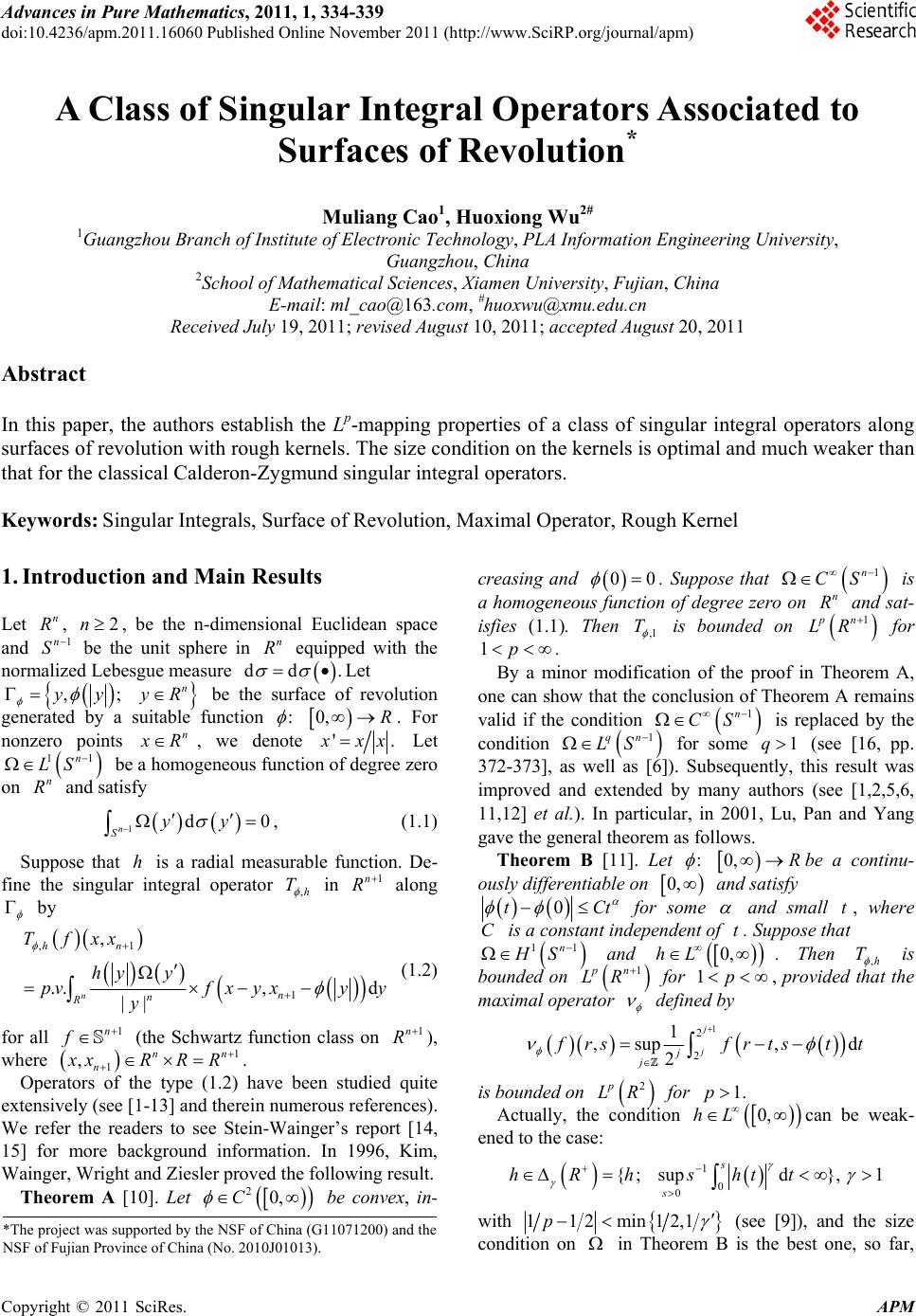 Advances in Pure Mathematics, 2011, 1, 334-339 doi:10.4236/apm.2011.16060 Published Online November 2011 (http://www.SciRP.org/journal/apm) Copyright © 2011 SciRes. APM A Class of Singular Integral Operators Associated to Surfaces of Revolution* Muliang Cao1, Huoxiong Wu2# 1Guangzhou Branch of Institute of Electronic Technology, PLA Information Engineering University, Guangzhou, China 2School of Mathematical Sciences, Xiamen University, Fujian, China E-mail: ml_cao@163.com, #huoxwu@xmu.edu.cn Received July 19, 2011; revised August 10, 2011; accepted August 20, 2011 Abstract In this paper, the authors establish the Lp-mapping properties of a class of singular integral operators along surfaces of revolution with rough kernels. The size condition on the kernels is optimal and much weaker than that for the classical Calderon-Zygmund singular integral operators. Keywords: Singular Integrals, Surface of Revolution, Maximal Operator, Rough Kernel 1. Introduction and Main Results Let , , be the n-dimensional Euclidean space and be the unit sphere in equipped with the normalized Lebesgue measure Let n R n S 2n 1n R dd . ,; n yy yR n be the surface of revolution generated by a suitable function . For nonzero points :0, R R, we denote '. xx Let be a homogeneous function of degree zero on and satisfy n 1 1 LS n R 1d n Syy 0, (1.1) Suppose that is a radial measurable function. De- fine the singular integral operator h ,h T in 1n R along by ,1 1 , .., d || n hn n n R Tfxx hy y pvfxy xyy y (1.2) for all (the Schwartz function class on 1n f 1n R ), where 1 ,n 1nn xRRR . Operators of the type (1.2) have been studied quite extensively (see [1-13] and therein numerous references). We refer the readers to see Stein-Wainger’s report [14, 15] for more background information. In 1996, Kim, Wainger, Wright and Ziesler proved the following result. Theorem A [10]. Let be convex, in- creasing and 20,C 00 . Suppose that 1n CS n R is a homogeneous function of degree zero on and sat- isfies (1.1). Then ,1 T is bounded on 1pn LR for 1p . By a minor modification of the proof in Theorem A, one can show that the conclusion of Theorem A remains valid if the condition is replaced by the condition 1n CS 1qn LS for some (see [16, pp. 372-373], as well as [6]). Subsequently, this result was improved and extended by many authors (see [1,2,5,6, 11,12] et al.). In particular, in 2001, Lu, Pan and Yang gave the general theorem as follows. 1 R q Theorem B [11]. Let be a continu- ously differentiable on :0, 0, and satisfy 0tCt for some and small , where is a constant independent of . Suppose that t C t 11n HS and 0,hL . Then ,h T is bounded on 1pn LR for 1, provided that the maximal operator p defined by 1 2 2 1 p 2 j j j ,s j u , d rs f r tst t is bounded on 2p LR for 1.p hL Actually, the condition can be weak- ened to the case: 0, 1 0 0 {; s hsups hR sh d}, 1tt with 11 12,1p2min (see [9]), and the size condition on in Theorem B is the best one, so far, *The project was supported by the NSF of China (G11071200) and the SF of Fujian Province of China (No. 2010J01013). 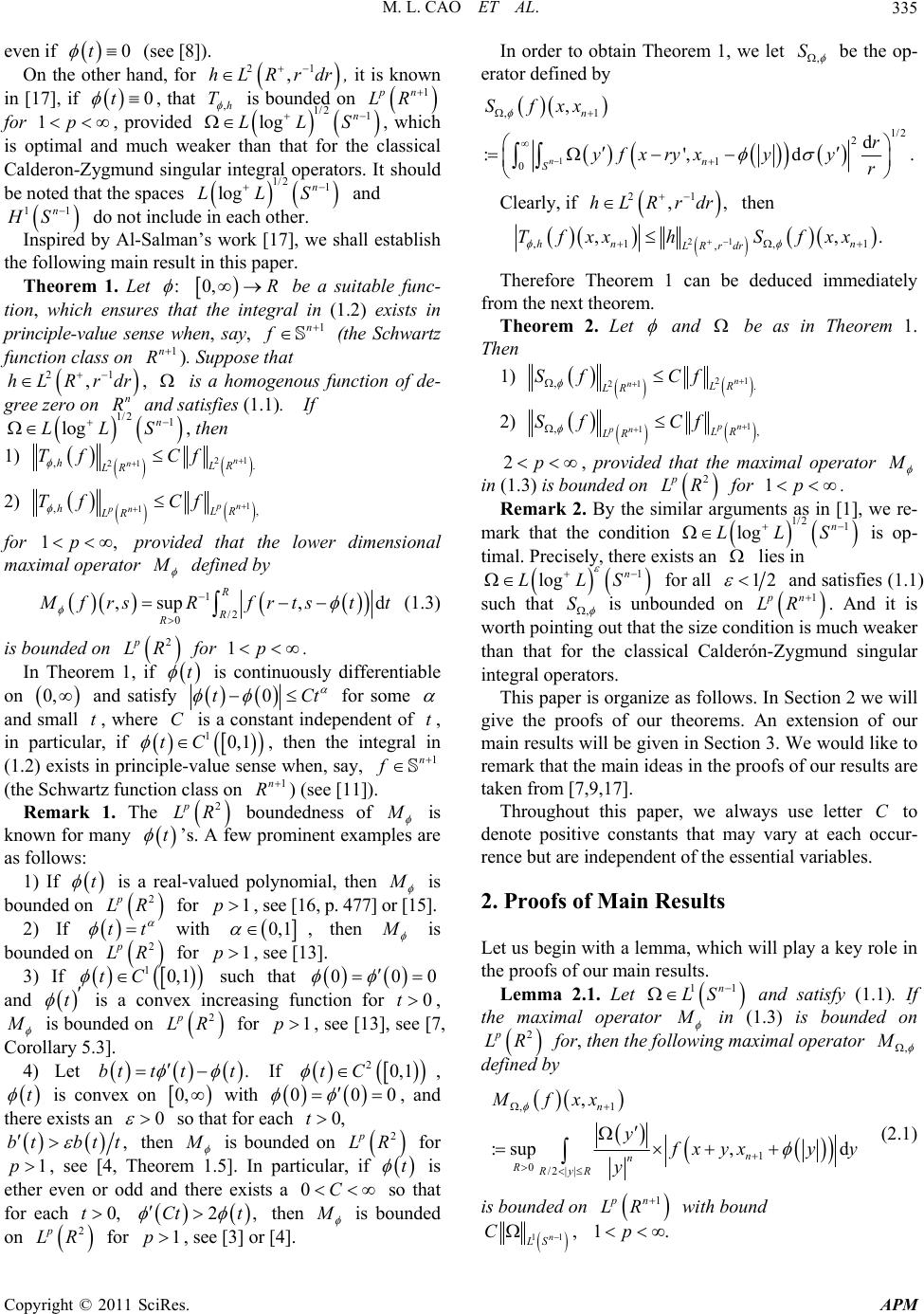 M. L. CAO ET AL.335 even if (see [8]). 0t t On the other hand, for , it is known in [17], if , that 21 ,hLRrdr ,h T0 is bounded on 1pn LR 1 S for , provided , which is optimal and much weaker than that for the classical Calderon-Zygmund singular integral operators. It should be noted that the spaces and do not include in each other. 1 1n HS p 1 21 ,Rrdr n R 1/2 logLL 1/2 logLL 1/2 1 log n LLS n Inspired by Al-Salman’s work [17], we shall establish the following main result in this paper. Theorem 1. Let be a suitable func- tion, which ensures that the integral in (1.2) exists in principle-value sense when, say, (the Schwartz function class on ). Suppose that , is a homogenous function of de- gree zero on and satisfies (1.1). If , then :0, R f 1n 1n S 1n R hL 1) 21 21 ,n h Tf . n LR LR f C 2) 1 1 ,, pn pn hLR LR Tf Cf for provided that the lower dimensional maximal operator 1p, defined by 1 /2 0 ,sup, d R R R frsRfrtstt (1.3) is bounded on for 1 2p LR p . In Theorem 1, if t is continuously differentiable on and satisfy 0, 0tCt for some and small , where is a constant independent of , in particular, if , then the integral in (1.2) exists in principle-value sense when, say, t C t 1n 10,1tC f (the Schwartz function class on ) (see [11]). 1n R 2 Remark 1. The boundedness of p LR is known for many t ’s. A few prominent examples are as follows: 1) If t is a real-valued polynomial, then is bounded on for , see [16, p. 477] or [15]. 2p LR tt 1p 2) If with 0,1 , then is bounded on for , see [13]. 2p LR 1 tC 1p 3) If such that 0,1 00 0 0t and is a convex increasing function for , t is bounded on for , see [13], see [7, Corollary 5.3]. 2p LR 1p 4) Let If .btt tt 20,1tC , t is convex on with , and there exists an 0, 0 000 so that for each 0,t ,bt bt t then is bounded on 2p LR for , see [4, Theorem 1.5]. In particular, if 1p t is ether even or odd and there exists a so that for each 0C 0,t 2t ,Ct then is bounded on for , see [3] or [4]. 2p LR 1p In order to obtain Theorem 1, we let , S be the op- erator defined by 1 ,1 1/ 2 2 1 0 , d :',d n n n S Sfxx r yfxryxyy r . Clearly, if 21 ,hLRrdr , then 21 ,1 , , ,, hn n LRr dr TfxxhS fxx 1 . Therefore Theorem 1 can be deduced immediately from the next theorem. Theorem 2. Let and be as in Theorem 1. Then 1) 21 21 ,. n nLR LR Sf Cf 2) 1 1 ,, pn pn LR LR Sf Cf 2p , provided that the maximal operator in (1.3) is bounded on 2p LR for 1. p Remark 2. By the similar arguments as in [1], we re- mark that the condition is op- timal. Precisely, there exists an lies in for all 1/2 1 log n LLS 1 log n LLS 12 and satisfies (1.1) such that , S is unbounded on . And it is worth pointing out that the size condition is much weaker than that for the classical Calderón-Zygmund singular integral operators. 1pn LR This paper is organize as follows. In Section 2 we will give the proofs of our theorems. An extension of our main results will be given in Section 3. We would like to remark that the main ideas in the proofs of our results are taken from [7,9,17]. Throughout this paper, we always use letter to denote positive constants that may vary at each occur- rence but are independent of the essential variables. C 2. Proofs of Main Results Let us begin with a lemma, which will play a key role in the proofs of our main results. Lemma 2.1. Let and satisfy (1.1). If the maximal operator 11n LS in (1.3) is bounded on 2p LR for, then the following maximal operator , M defined by ,1 1 0/2 | | , :sup, d n n n RRyR Mfxx y xyxyy y (2.1) is bounded on 1pn LR with bound 11 ,1 .Cp n LS Copyright © 2011 SciRes. APM 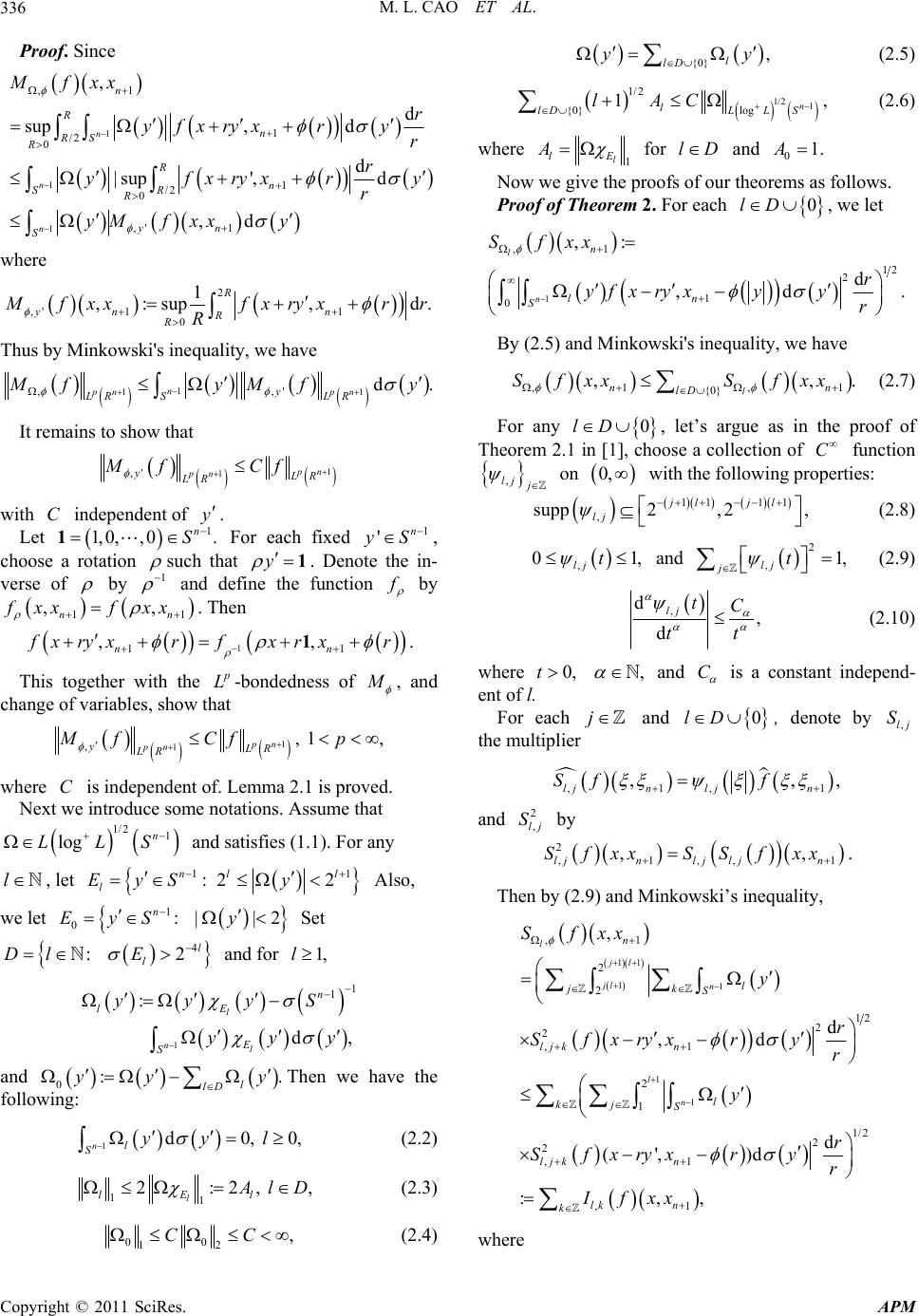 M. L. CAO ET AL. 336 Proof. Since 1 1 1 ,1 1 /2 0 1 /2 0 ,' 1 , d sup, d d |sup ',d ,d n n n n R n RS R R n SR R yn S Mfxx r yfxryx r y r r yfxryxr r yMf xxy y where 2 ,' 11 0 1 ,:sup, d R yn n R R . fxxfxryxrr R Thus by Minkowski's inequality, we have 1 11 ,,' d. n pn pn y S LR LR fyMf y It remains to show that 1 1 ,pn pn yLR LR Mf Cf with independent of . C 1y 1. n Let For each fixed 1, 0,,0S1 'n S , choose a rotation such that y 1. Denote the in- verse of by 1 and define the function by . Then 11 ,, nn xf xx fx 1 11 ,, nn xryxr fxrxr 1 . This together with the L-bondedness of , and change of variables, show that 1 1 ,, 1, pn pn yLR LR Mf Cfp where is independent of. Lemma 2.1 is proved. C Next we introduce some notations. Assume that and satisfies (1.1). For any 1/2 1 log n LLS l, let 11 : 22 nl l l EyS y Also, we let Set 1 0:| |2 n EySy 4 :l l Dl E 2 and for 1,l 1 1 1 : d, l nl n lE E S yyyS yyy and 0:. l lD y y 0, Then we have the following: 1d0, nl Syyl (2.2) 11 2:2, l lEl , lD (2.3) 00 12 ,CC (2.4) {0} , l lD y y (2.5) 1/ 21 1/2 {0} log 1, n l lD LLS lAC (2.6) where 1 l lE A for lD and 01.A Now we give the proofs of our theorems as follows. Proof of Theorem 2. For each 0lD , we let 1 ,1 12 2 1 0 ,: d ,d l n n ln S Sfxx r yfx ryxyyr . By (2.5) and Minkowski's inequality, we have ,1 , {0} ,, l nn lD SfxxS fxx 1 . (2.7) For any 0lD , let’s argue as in the proof of Theorem 2.1 in [1], choose a collection of C function ,lj on 0, with the following properties: supp 11 11 ,2,2 jl jl lj , (2.8) , 01 lj t , and (2.9) 2 ,1, lj jt , d, d lj tC tt (2.10) where 0,t, and C is a constant independ- ent of l. For each j and 0lD , denote by the multiplier ,lj S ,1, ,, ljn ljn Sf f 1 , and by 2 , lj S 2 ,1,, ,, ljnljljn Sfxx SSfxx 1 . Then by (2.9) and Minkowski’s inequality, 11 11 1 1 ,1 2 2 12 2 2 ,1 2 1 1/2 2 2 ,1 ,1 , d ,d d (',)d :,, l jl jl n l n n l jk S lj kn l kj S lj kn lk n k Sfxx y r Sfxryxr y r y r Sfxryxr y r Ifxx where Copyright © 2011 SciRes. APM 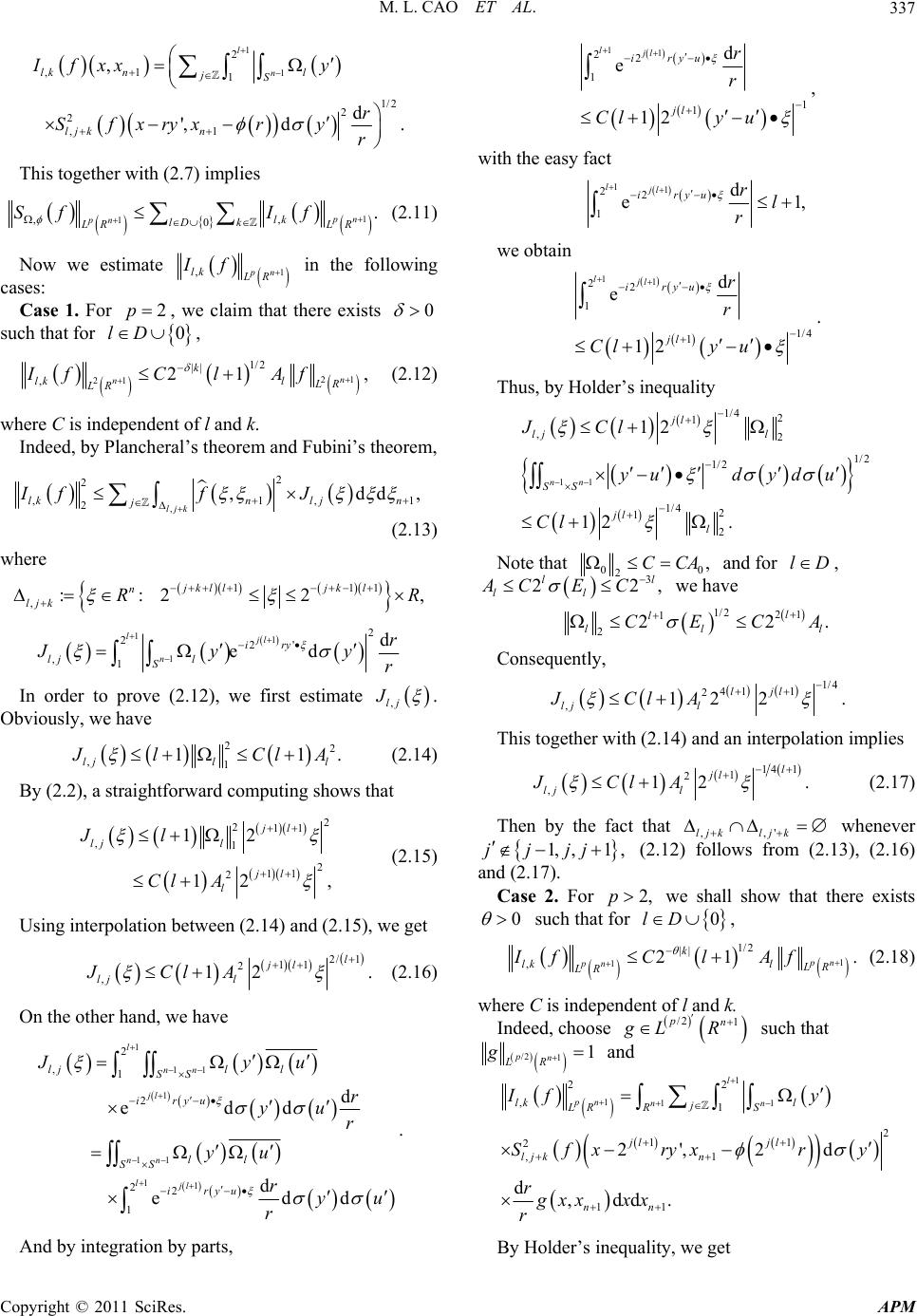 M. L. CAO ET AL.337 1 1 2 ,11 1/2 2 2 ,1 , d ',d. l n lk nl jS lj kn Ifxxy r Sfxryxry r This together with (2.7) implies 1 1 ,, 0. pn pn lk lD kLR LR Sf If (2.11) Now we estimate 1 ,pn lk LR If in the following cases: Case 1. For , we claim that there exists 2p0 such that for , lD 0 21 21 1/2 || ,21 n n k lkl LR LR IfC lAf , (2.12) where C is independent of l and k. Indeed, by Plancheral’s theorem and Fubini’s theorem, , 2 2 ,1,1 2,dd, ljk lknl jn j Iff J (2.13) where R 111 ,::22, jklljkl n lj kR 11 1 2 22' ,1 d ed ljl n iry lj l S r Jy r y In order to prove (2.12), we first estimate ,lj J . Obviously, we have 22 ,1 11 ljll . lClA (2.14) By (2.2), a straightforward computing shows that 2 211 ,1 2 11 2 12 12, jl lj l jl l Jl Cl A (2.15) Using interpolation between (2.14) and (2.15), we get 2/ 1 11 2 ,12 l jl ljl JClA . (2.16) On the other hand, we have 1 11 1 11 11 2 ,1 2 22 1 d edd d edd l nn jl nn ljl ljll SS iryu ll SS iryu Jyu r yu r yu ryu r . And by integration by parts, 11 22 1 1 1 d e 12 ljl iryu jl r r Cly u , with the easy fact 11 22 1 d e1 ljl iryurl r , we obtain 11 22 1 1/4 1 d e 12 ljl iryu jl r r Cly u . Thus, by Holder’s inequality 11 1/4 2 1 ,2 1/2 1/2 1/4 2 1 2 12 12 . nn jl lj l SS jl l JCl yudydu Cl Note that 00 2,CCA and for , lD 3 2 ll ll ACE C 2, we have 1/2 21 1 222 l l ll CEC . l A Consequently, 1/4 41 1 2 ,12 2 ljl ljl JClA . This together with (2.14) and an interpolation implies 14 1 1 2 ,12 l jl ljl JClA . (2.17) Then by the fact that ,,'lj kljk whenever 1,,1 ,jjjj (2.12) follows from (2.13), (2.16) and (2.17). Case 2. For we shall show that there exists 2,p 0 such that for , 0lD 1 1 1/2 || ,21 pn pn k lkl LR LR IfC lAf . (2.18) where C is independent of l and k. Indeed, choose such that /2 1 pn gL R /2 11 pn LR g and 1 2l 111 2 ,1 2 11 2 ,1 11 2',2 d d,dd. pn nn lk l j LR RS jl jl lj kn nn If y Sfxryxr y rgxx xx r By Holder’s inequality, we get Copyright © 2011 SciRes. APM 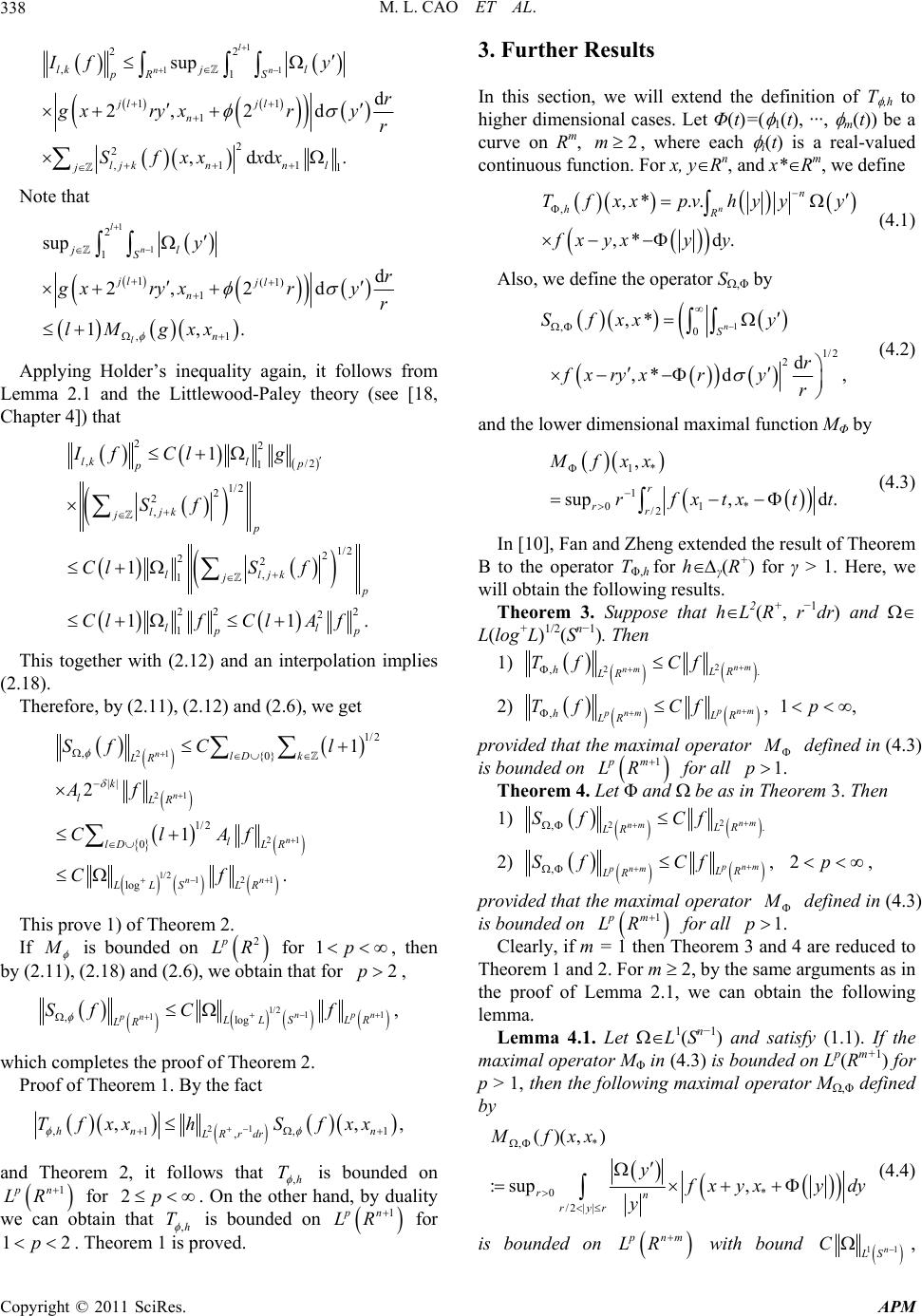 M. L. CAO ET AL. 338 1 11 2 2 ,1 11 1 2 2 ,11 1 sup d 2,2 d ,dd. l nn lkj l pRS jl jl n lj knnl j If y r gxryxryr Sfxx xx Note that 1 1 2 1 1(1) 1 ,1 sup d 2,2 d 1,. l n l jl S jl jl n n y r gxryxryr lM gxx Applying Holder’s inequality again, it follows from Lemma 2.1 and the Littlewood-Paley theory (see [18, Chapter 4]) that 22 ,/2 1 1/2 2 2 , 1/2 2 22 , 1 22 2 2 1 1 1 11 lkl p p lj k j p lljk j . ll p If Clg Sf ClSf ClfClA f This together with (2.12) and an interpolation implies (2.18). Therefore, by (2.11), (2.12) and (2.6), we get 21 21 21 1/2 121 1/2 ,{0} || 1/ 2 0 log 1 2 1 . n n n nn lDk LR k lLR l lD LR LLSLR Sf Cl Af ClAf Cf This prove 1) of Theorem 2. If is bounded on 2p LR for 1, then by (2.11), (2.18) and (2.6), we obtain that for , p 2p 1/2 11 1 ,log , npn pn LLSLR LR Sf Cf which completes the proof of Theorem 2. Proof of Theorem 1. By the fact 21 ,1 , , ,, 1hn n LRr dr TfxxhS fxx , and Theorem 2, it follows that ,h T is bounded on for . On the other hand, by duality we can obtain that ,h T 1pn LR 3. Further Results In this section, we will extend the definition of T ,h to higher dimensional cases. Let Φ(t)=( 1(t), ···, m(t)) be a curve on Rm, , where each i(t) is a real-valued continuous function. For x, yRn, and x*Rm, we define 2m ,,* .. ,* d. n n hR Tfxx pvhyyy fx yxyy (4.1) Also, we define the operator S,Φ by 1 ,0 1/2 2 ,* d ,* d, n S Sfxx y r fx ryxryr (4.2) and the lower dimensional maximal function MΦ by 1* 1 01* /2 , sup,d . r rr Mfxx rfxtxt t (4.3) In [10], Fan and Zheng extended the result of Theorem B to the operator TΦ,h for h∆γ(R+) for γ > 1. Here, we will obtain the following results. Theorem 3. Suppose that hL2(R+, r −1dr) and L(log+L)1/2(Sn−1). Then 1) 2 2 ,. nm nm hLR LR TfCf 2) , nm pnm hLR LR TfCf , 1,p provided that the maximal operator defined in (4.3) is bounded on 1pm LR for all 1.p Theorem 4. Let Φ and be as in Theorem 3. Then 1) 2 2 ,. nm nm LR LR SfCf 2) ,, pnm pnm LR LR SfCf , 2p provided that the maximal operator defined in (4.3) is bounded on 1pm LR for all 1.p Clearly, if m = 1 then Theorem 3 and 4 are reduced to Theorem 1 and 2. For m 2, by the same arguments as in the proof of Lemma 2.1, we can obtain the following lemma. Lemma 4.1. Let L1(Sn−1) and satisfy (1.1). If the maximal operator MΦ in (4.3) is bounded on Lp(Rm+1) for p > 1, then the following maximal operator M,Φ defined by ,* 0* /2 | | ()(, ) :sup , rn ryr Mfxx yfx yxydy y (4.4) 2p is bounded on for . Theorem 1 is proved. 1pn LR 21p is bounded on nm LR with bound 11n LS C , Copyright © 2011 SciRes. APM 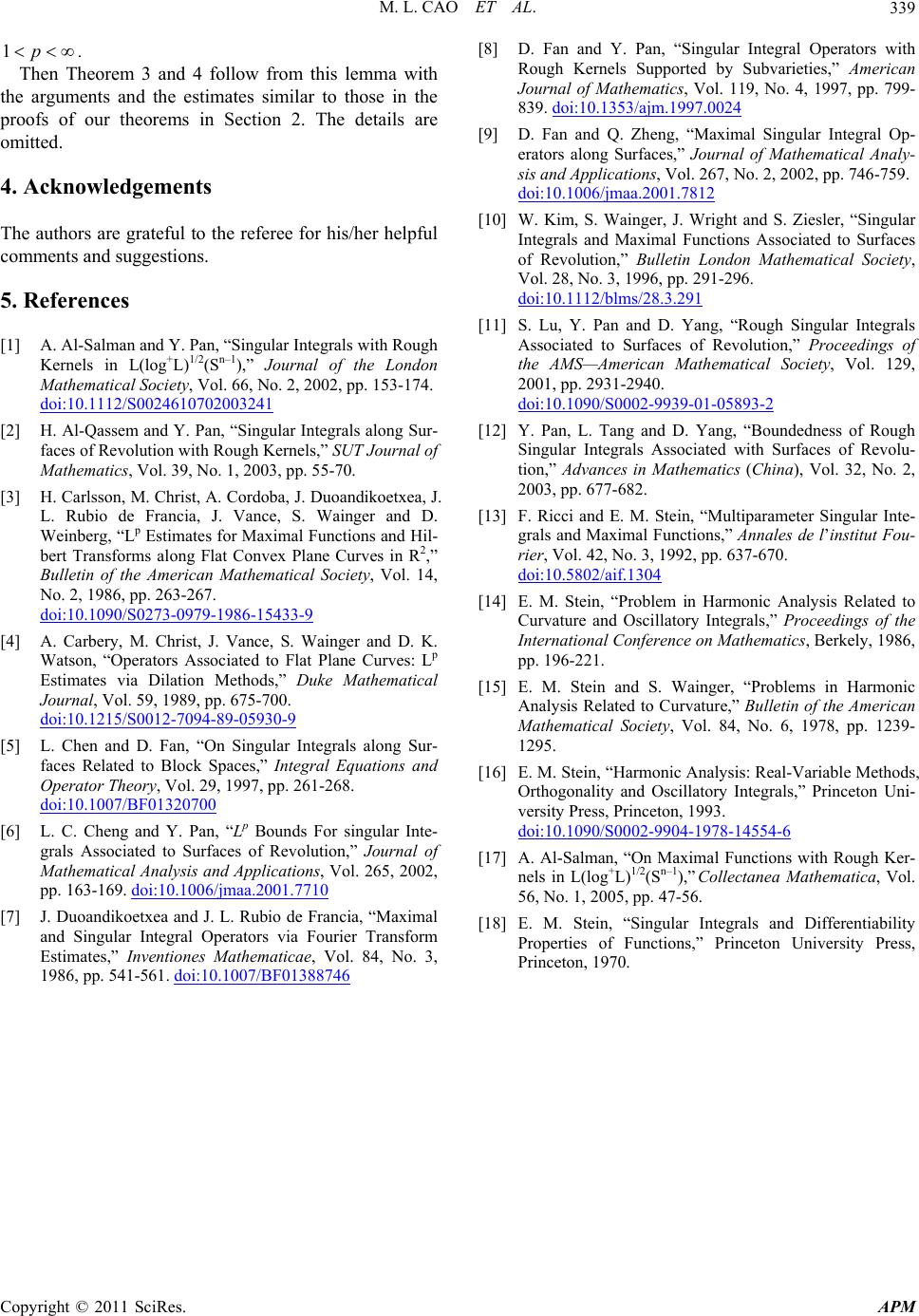 M. L. CAO ET AL. Copyright © 2011 SciRes. APM 339 [8] D. Fan and Y. Pan, “Singular Integral Operators with Rough Kernels Supported by Subvarieties,” American Journal of Mathematics, Vol. 119, No. 4, 1997, pp. 799- 839. doi:10.1353/ajm.1997.0024 1p . Then Theorem 3 and 4 follow from this lemma with the arguments and the estimates similar to those in the proofs of our theorems in Section 2. The details are omitted. [9] D. Fan and Q. Zheng, “Maximal Singular Integral Op- erators along Surfaces,” Journal of Mathematical Analy- sis and Applications, Vol. 267, No. 2, 2002, pp. 746-759. doi:10.1006/jmaa.2001.7812 4. Acknowledgements [10] W. Kim, S. Wainger, J. Wright and S. Ziesler, “Singular Integrals and Maximal Functions Associated to Surfaces of Revolution,” Bulletin London Mathematical Society, Vol. 28, No. 3, 1996, pp. 291-296. doi:10.1112/blms/28.3.291 The authors are grateful to the referee for his/her helpful comments and suggestions. 5. References [11] S. Lu, Y. Pan and D. Yang, “Rough Singular Integrals Associated to Surfaces of Revolution,” Proceedings of the AMS—American Mathematical Society, Vol. 129, 2001, pp. 2931-2940. doi:10.1090/S0002-9939-01-05893-2 [1] A. Al-Salman and Y. Pan, “Singular Integrals with Rough Kernels in L(log+L)1/2(Sn–1),” Journal of the London Mathematical Society, Vol. 66, No. 2, 2002, pp. 153-174. doi:10.1112/S0024610702003241 [12] Y. Pan, L. Tang and D. Yang, “Boundedness of Rough Singular Integrals Associated with Surfaces of Revolu- tion,” Advances in Mathematics (China), Vol. 32, No. 2, 2003, pp. 677-682. [2] H. Al-Qassem and Y. Pan, “Singular Integrals along Sur- faces of Revolution with Rough Kernels,” SUT Journal of Mathematics, Vol. 39, No. 1, 2003, pp. 55-70. [3] H. Carlsson, M. Christ, A. Cordoba, J. Duoandikoetxea, J. L. Rubio de Francia, J. Vance, S. Wainger and D. Weinberg, “Lp Estimates for Maximal Functions and Hil- bert Transforms along Flat Convex Plane Curves in R2,” Bulletin of the American Mathematical Society, Vol. 14, No. 2, 1986, pp. 263-267. doi:10.1090/S0273-0979-1986-15433-9 [13] F. Ricci and E. M. Stein, “Multiparameter Singular Inte- grals and Maximal Functions,” Annales de l’institut Fou- rier, Vol. 42, No. 3, 1992, pp. 637-670. doi:10.5802/aif.1304 [14] E. M. Stein, “Problem in Harmonic Analysis Related to Curvature and Oscillatory Integrals,” Proceedings of the International Conference on Mathematics, Berkely, 1986, pp. 196-221. [4] A. Carbery, M. Christ, J. Vance, S. Wainger and D. K. Watson, “Operators Associated to Flat Plane Curves: Lp Estimates via Dilation Methods,” Duke Mathematical Journal, Vol. 59, 1989, pp. 675-700. doi:10.1215/S0012-7094-89-05930-9 [15] E. M. Stein and S. Wainger, “Problems in Harmonic Analysis Related to Curvature,” Bulletin of the American Mathematical Society, Vol. 84, No. 6, 1978, pp. 1239- 1295. [5] L. Chen and D. Fan, “On Singular Integrals along Sur- faces Related to Block Spaces,” Integral Equations and Operator Theory, Vol. 29, 1997, pp. 261-268. doi:10.1007/BF01320700 [16] E. M. Stein, “Harmonic Analysis: Real-Variable Methods, Orthogonality and Oscillatory Integrals,” Princeton Uni- versity Press, Princeton, 1993. doi:10.1090/S0002-9904-1978-14554-6 [6] L. C. Cheng and Y. Pan, “Lp Bounds For singular Inte- grals Associated to Surfaces of Revolution,” Journal of Mathematical Analysis and Applications, Vol. 265, 2002, pp. 163-169. doi:10.1006/jmaa.2001.7710 [17] A. Al-Salman, “On Maximal Functions with Rough Ker- nels in L(log+L)1/2(Sn–1),” Collectanea Mathematica, Vol. 56, No. 1, 2005, pp. 47-56. [7] J. Duoandikoetxea and J. L. Rubio de Francia, “Maximal and Singular Integral Operators via Fourier Transform Estimates,” Inventiones Mathematicae, Vol. 84, No. 3, 1986, pp. 541-561. doi:10.1007/BF01388746 [18] E. M. Stein, “Singular Integrals and Differentiability Properties of Functions,” Princeton University Press, Princeton, 1970.
|